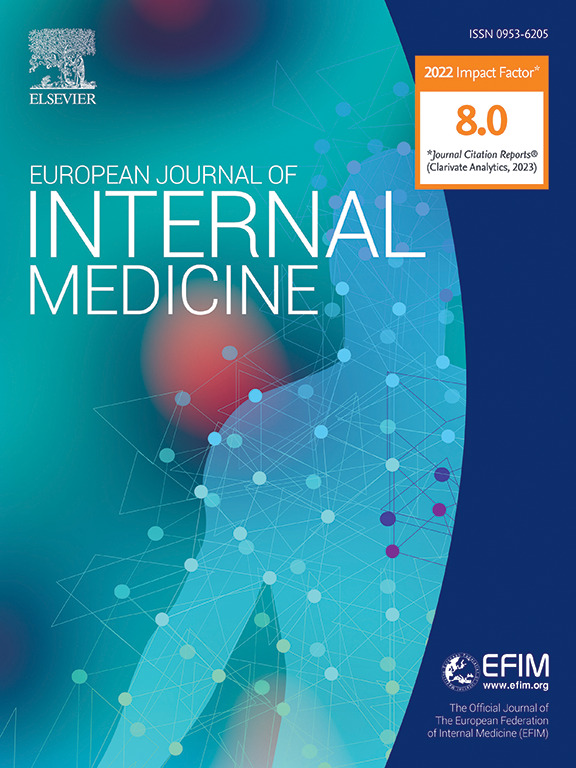Efficacy and safety of once-daily oral semaglutide in patients with heart failure with preserved ejection fraction, type 2 diabetes and obesity: a real-world study
IF 6.1
2区 医学
Q1 MEDICINE, GENERAL & INTERNAL
引用次数: 0
Abstract
Background
There is limited evidence on the role of glucagon-like peptide-1 receptor agonists in heart failure. This work analyzes the efficacy of once-daily oral semaglutide in terms of health status and change in body weight in patients with heart failure with preserved ejection fraction, type 2 diabetes, and obesity.
Methods
This prospective, real-world study included patients treated with once-daily semaglutide (O-Sema Group) and without glucagon-like peptide-1 receptor agonists (Control Group). The primary outcome was the heart failure status, defined as the ≥5 point difference in the Kansas City Cardiomyopathy Questionnaire total symptom score, and change in body weight at 18 months.
Results
After a 1:1 propensity score matching, 202 patients were included in each group (mean age 77.8 years, mean body mass index 33.5, 59.2 % females). Patients in the O-Sema Group were more likely to have an improvement in heart failure health status from baseline to 18 months (OR:2.92; 95 %CI: 1.45–4.90; p < 0.01). The mean change in body weight was -9.5 ± 3.2 kg in patients with oral semaglutide and -2.0 ± 1.1 kg in control patients (p < 0.01). After treatment, there were negative correlations between the Kansas City Cardiomyopathy Questionnaire total symptom score and the body weight (r=-0.577, p < 0.01) and glycated hemoglobin (r=-0.499, p = 0.011). It had good tolerability and safety.
Conclusions
Once-daily oral semaglutide was associated with an improvement in heart failure health status, and weight loss in patients with heart failure with preserved ejection fraction, type 2 diabetes, and obesity. Further research on glucagon-like peptide-1 receptor agonists in heart failure with preserved ejection fraction is needed.
每日一次口服西马鲁肽对保留射血分数、2型糖尿病和肥胖的心力衰竭患者的疗效和安全性:一项现实世界的研究
背景:关于胰高血糖素样肽-1受体激动剂在心力衰竭中的作用的证据有限。本研究分析了每日一次口服西马鲁肽对保留射血分数的心力衰竭、2型糖尿病和肥胖患者的健康状况和体重变化的影响。方法:这项前瞻性、现实世界的研究纳入了每日一次使用西马鲁肽(O-Sema组)和不使用胰高血糖素样肽-1受体激动剂(对照组)的患者。主要终点是心衰状态,定义为堪萨斯城心肌病问卷总症状评分差≥5分,以及18个月时体重的变化。结果:经1:1倾向评分匹配后,每组纳入202例患者(平均年龄77.8岁,平均体重指数33.5,女性占59.2%)。O-Sema组患者从基线到18个月心力衰竭健康状况改善的可能性更大(OR:2.92;95% ci: 1.45-4.90;P < 0.01)。口服西马鲁肽组体重平均变化为-9.5±3.2 kg,对照组为-2.0±1.1 kg (p < 0.01)。治疗后,堪萨斯城心肌病问卷总症状评分与体重(r=-0.577, p < 0.01)、糖化血红蛋白(r=-0.499, p = 0.011)呈负相关。具有良好的耐受性和安全性。结论:每日一次口服西马鲁肽可改善心力衰竭健康状况,并可减轻伴有射血分数保留、2型糖尿病和肥胖的心力衰竭患者的体重。胰高血糖素样肽-1受体激动剂在保留射血分数的心力衰竭中的作用有待进一步研究。
本文章由计算机程序翻译,如有差异,请以英文原文为准。
求助全文
约1分钟内获得全文
求助全文
来源期刊
CiteScore
9.60
自引率
6.20%
发文量
364
审稿时长
20 days
期刊介绍:
The European Journal of Internal Medicine serves as the official journal of the European Federation of Internal Medicine and is the primary scientific reference for European academic and non-academic internists. It is dedicated to advancing science and practice in internal medicine across Europe. The journal publishes original articles, editorials, reviews, internal medicine flashcards, and other relevant information in the field. Both translational medicine and clinical studies are emphasized. EJIM aspires to be a leading platform for excellent clinical studies, with a focus on enhancing the quality of healthcare in European hospitals.

 求助内容:
求助内容: 应助结果提醒方式:
应助结果提醒方式:


